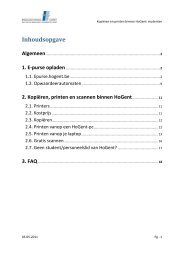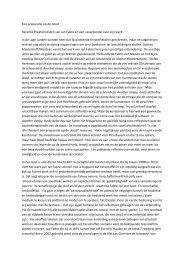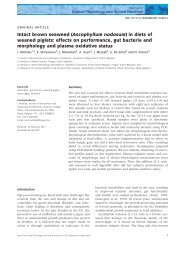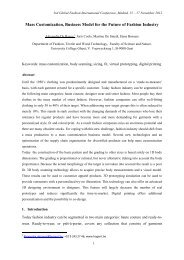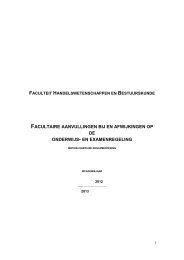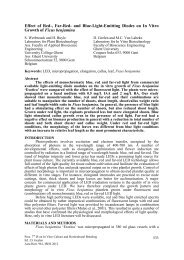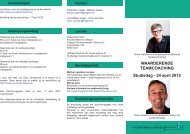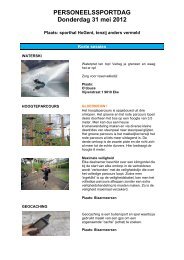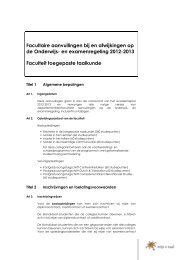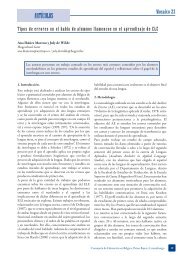Revision2 - Hogeschool Gent
Revision2 - Hogeschool Gent
Revision2 - Hogeschool Gent
You also want an ePaper? Increase the reach of your titles
YUMPU automatically turns print PDFs into web optimized ePapers that Google loves.
1Cloud-based Desktop Services for Thin ClientsLien Deboosere, Bert Vankeirsbilck, Pieter Simoens, Filip De Turck, Bart Dhoedt and Piet DemeesterAbstract—Cloud computing and ubiquitous network availabilityhas brought the thin client concept again under the attention.Executing applications in virtual desktops on servers in thecloud enables accessing any application from any location withany device. To be a successful alternative for traditional offlineapplications, important challenges have to be overcome. Firstof all, the performance of the thin client protocol is essential:the audiovisual output has to be displayed fluently. Second, thedesktop should be executed on a server with sufficient resources,ideally close to the user’s current location to limit the impactof network delay on the interactivity. In addition to deliveringexcellent user experience, reducing costs is important for serviceproviders. This paper discusses these challenges from both theuser’s and the service provider’s point-of-view and roads tosolutions enabling cloud-based desktop services for thin clients.I. INTRODUCTIONRECENTLY, cloud computing [1] services have becomewidely available, offering an on-demand availability ofcomputing resources (e.g. Amazon EC2). Thanks to theseadvances and ubiquitous network availability, the thin clientcomputing paradigm is enjoying an ever increasing popularity.The paradigm, originally intended for wired local areanetwork (LAN) environments [2], is repeating its success inthe mobile context. Furthermore, a study from ABI Researchforecasts a 20 B$ turnover associated with services directlyassociated with mobile cloud computing by the end of 2014.Clearly, when offloading is applied, the functionality of theterminal is limited to presenting audiovisual output to the userand to conveying user input to the remote servers, therebyconsiderably reducing the computational complexity on theclient device. Consequently, these applications can be run asis,without the need to provide (many) scaled-down versionsfor mobile devices.Currently, popular applications are already executed onservers in the cloud (e.g., Google Docs, Microsoft Live).Accessing applications in the cloud is referred to as Softwareas-a-Service(SaaS), while hosting a virtual desktop (VD) isreferred to as Desktop-as-a-Service (DaaS). DaaS implementationscan be categorized according to the location wherethe VD is executed (locally or remotely) or according to themethod to access the output of the VD (browser or thin clientprotocol such as Microsoft’s Remote Desktop Protocol (RDP)and Virtual Network Computing (VNC)). This paper specificallyfocuses on mobile users, and hence, due to resourceconstraints, VDs are executed remotely. To enable access toexisting operating systems and applications, we will focuson using a thin client protocol to visualize the output ofapplications executed by a VD.All authors are with the Ghent University - INTEC - IBBT Belgium.Simoens is also affiliated with INWE, Ghent University College.Current DaaS deployments such as VMWare Virtual DesktopInfrastructure (VDI) are mainly concentrated in corporateenvironments. The availability of (virtual) computingresources distributed over the network makes cloud computinga big enabler for offering desktop services in mobile WANenvironments.In Fig. 1, we propose a system architecture for offeringefficient desktop services in the cloud. Simplified OS imagemanagement (i.e. re-using an OS image among users andconsequently reducing the storage per user) and applicationmanagement are essential for the scalability of the service. Inour system architecture, a VD is built from a shared goldenimage from the OS database, merged with personal settings,for example by using a copy-on-write solution with unionFS.Schwarzkopf et al. show how multi-layer VDs simplify thecomplexity of upgrading the golden image without causingbroken dependencies and/or conflicts [3]. To improve theusability of DaaS, combining DaaS with application virtualizationtechnologies such as Softricity and Microsoft App-V is very promising. The applications are then dynamicallydelivered to the user’s VD without the need for installing,configuring and updating the applications. This approach furtherreduces the complexity of upgrading golden images sinceapplications are not installed in the user’s VD and thus cannotbe broken.Existing cloud platforms fulfill the hardware requirementsto implement a DaaS service. However, we are witnessing theemergence of a new category of mobile applications (e.g., augmentedreality, rich sensing and multimedia editing), posingstringent requirements on delays. Current cloud managementsystems are not able to meet user expectations from these applications,especially in terms of latency. There is a clear needfor novel cloud management algorithms to take into accountthe specific requirements of mobile thin client computing. Inour system architecture, these cloud management algorithmsare implemented in the self management component of theservice manager, which can be implemented as part of existingcloud management systems such as OpenNebula, OpenStackand Eucalyptus.In this paper, we present and discuss solutions to adequatelyaddress the challenges for providers offering a cloud-baseddesktop service. First, we look at the service from the user’spoint-of-view and discuss how the user experience can beimproved. Second, from the service provider’s point-of-view,we discuss how to reduce the costs for offering the service.II. USER EXPERIENCETwo aspects are important for the user experience: (i) highperformance of the thin client protocol, i.e. crisp interactivityand fluent audiovisual output, and (ii) sufficient allocated resourceson the server-side so the applications respond quickly.
2thin clientusersself managementoverbooking allocationconsolidation relocationmonitoring frameworkdata centerapplicationvirtualizationserviceservice managerOS image& profiledatabasedata centerhost 1resourceoverbookingthin clientusersdata centerthin client userthin clientprotocol...host Hvirtualdesktops(VD)Fig. 1: System architecture to enable cloud-based desktop services for thin clients. Usersconnect via a thin client device (e.g., smartphone, tablet PC, PDA, netbook, minimal state orzero-state thin client device) to their remote applications executed in a virtual desktop. Theself management component of the service manager covers optimizations to increase the userexperience and decrease the costs of the service provider.For mobile users, it is also important to reduce the energyconsumption on the client device.A. Crisp interactivityAcceptable interaction delay bounds depend on the applicationat hand. For office automation applications, delaysup to 150ms can be tolerated [4], while for multimediaapplications such as video games, users are already susceptiblefor interaction delays higher than 80 ms. Because the resultof user input can only be seen after at least one round-triptime (RTT), delay for critical applications should be addressedthrough the use of a proximate server. Every time a userconnects to the service, a data center has to be selected thatcan be reached fast enough from the user’s current location.Inside the data center, the selection of an appropriate serveris based on the expected resource requirements of the user’sapplications based on the user’s profile and the current loadon the servers (see section II-C).Due to user mobility, guaranteeing delay bounds can implythat a VD is to be migrated to another server. In practice, thedesktop service is continuously monitored and, for example,when the RTT exceeds a predefined boundary based on thetype of active applications, the user’s VD is relocated to a moresuitable host. The relocation is performed by live migration ofthe VD [5].By storing the unionFS delta filesystem of the VDs onnetwork storage equipment, the cost of relocating VDs fromthe service provider’s point-of-view is reduced to copyingthe current active memory and in worst-case (i.e. migrationacross data centers) also copying the delta filesystem of theVDs. During the migration process, resources are required onboth the original and target host. In a heavily loaded system,these double resource reservations can lead to rejecting newuser requests while also causing substantial network trafficfor the memory copying process. Therefore, relocating VDsshould only be performed when valuable improvements forthe customer and/or the service provider can be achieved.B. Fluent audiovisual outputMultimedia content has been a stumbling block for thinclient computing for many years, especially in mobile WANenvironments where bandwidth availability is limited and expensive,mainly due to the fact that the same coding is appliedto static (e.g., text editing) and to dynamic (e.g., video game)content. Recently, several bandwidth optimizations for thinclient protocols have been proposed. An important innovationimplements a channel to redirect multimedia in its originalformat to the client (e.g. Citrix SpeedScreen), at least whenthe appropriate codec is available on the client device. Thisapproach is only valid for playing multimedia streams and notfor displaying high-motion output from an application (e.g., avideo game). We have evaluated a thin client protocol optimizationthat encodes the high-motion output of applicationswith a video codec and switches to a thin client protocolto encode low-motion output [6] and show its feasibility forpopular mobile devices in Table I. In these experiments, a fullscreenvideo was played on the server and streamed to theclient. Since the bottleneck of the live encoding process is theCPU of the server, higher framerates are reached for smallerscreen resolutions. Using the processing power of a GraphicalProcessing Unit (GPU) on the server-side could improve theframerate.
3device screen resolution available codecs streaming framerate [fps]iPhone 4 640 x 960 H264, MPEG-4, M-JPEG 27Samsung Galaxy S 800 x 480 H263, H264, MPEG-4, WMV, VC-1 23iPad 1024 x 768 H264, MPEG-4, M-JPEG 20laptop 1280 x 1024 depends on OS/applications 12TABLE I: Comparison of the performance of thin client computing on popular mobile devices. The output of a graphicalintensiveapplication (i.e., a full-screen video) is live encoded with H264 before streaming to the client device. The bottleneck ofthe live encoding process is the CPU of the server. Therefore, a higher framerate can be reached for smaller screen resolutionsFig. 2: Simulation results of the proposed allocation algorithm in a scenario with 10 hosts and an average utilization of 90%.An SLA violation means that the user applications receive less resources than requested.Vankeirsbilck et al. propose to cache important outputsequences such as the desktop view and menu items to reduceboth the required bandwidth and the interaction delay [7].Simoens et al. present a complete overview of recent thin clientprotocol optimizations in [8].C. Resource allocationIn the data center, a suitable host to satisfy an arrivinguser request must be found. From the customer’s point-ofview,the least utilized host is preferable, while from theprovider’s point-of-view the host resulting in the least resourcefragmentation (i.e. the best-fit host) is preferable since this canreduce the energy consumption. The resources needed by auser are specified in a Service Level Agreement (SLA). Toobserve the balance expressed above, the allocation algorithmattributes a penalty of α for each request receiving too fewresources, and a penalty β related to resource fragmentation,i.e. to the amount of non-reserved resources on this host.The host with the lowest penalty is selected to handle theuser request. In Fig. 2, the influence of the ratio α/β on theprobability of SLA violations is shown for a simulation with10 hosts and an average utilization of 90%. In this context, anSLA violation implies that the user applications receive lessresources than requested. When α/β increases, i.e. when SLAviolations are expensive, the allocation algorithm is able toreduce the probability of SLA violations with 10%. An SLAviolation as defined here might not be noticeable or obstructivefor the user experience as it might just take some longer forthe user applications to execute a task.For scalability, we cannot assume that every user has adedicated profile. Rather, the resource requirements of VDsshould be clustered offline into a finite number of profiles. Atsubscription time, a user is assigned one of those predefinedprofiles. An online clustering algorithm such as the decentralizedclustering algorithm presented by Quiroz et al. [9] couldbe used to map the current resource requirements of a user’sVD to one of the cluster profiles. This online mapping can beused to adapt the current resource allocation or even the user’sprofile when appropriate.In case the current resource requirements do not correspondwith the user’s profile (e.g., bursts of SLA violationsare detected), the cloud management can decide, based onthe user’s SLA contract, to adapt the resource allocation tothe current needs. In case more resources are required andsufficient resources are available on the current host, theseadditional resources are simply allocated. A problem ariseswhen the current host cannot update the resource reservationto the desired level. Two actions can be taken: relocating theuser’s VD to a host with sufficient free resources, or relocatingother VDs from the current host until sufficient resources arefreed. The preferred choice depends on several factors such asthe users’ SLA contracts and the memory consumption of theVDs which is known to determine the time required to finishthe live migration of a VD.D. Battery autonomyLimited battery drain is important for mobile users. Sincethe computing power is shifted to the network, one couldexpect a small battery drain, but on the other hand, thecontinuous wireless network connection is a huge batteryconsumer.Several approaches exist to reduce the energy consumptionof the wireless network connection, for example, Simoenset al. propose a cross-layer optimization [8]. Even with this
4Fig. 3: Non-consumed reserved resources are collected in the host’s resource pool to be shared among VDs requesting moreresources than reserved. The presented simulation results (averaged over 15 simulations) concern a fully reserved host withnormal VDs requesting resources (based on the planning guide by Citrix Inc. [11]) according to a normal distribution N(µ, σ 2 )with µ taken from N(10, 3.5) and σ 2 taken from N(3.5, (2/3 × 3.5)).adaptation, offloading all applications cannot be justified interms of reducing energy consumption. Therefore, we proposeto weigh the advantages of offloading an application to aremote server versus local execution of the application. Lu etal. propose a solution between these two extremes: offloadingparts of the applications and rendering to remote servers andexecuting the other parts locally, which could also reduce theinteraction delay [10].III. SERVICE PROVIDER COSTSThe most important challenge for a service provider issatisfying the customers while minimizing the costs. We focuson optimizing the number of users served by a single host andminimizing the energy consumption of the hosts in the cloud.A. Number of users served by one hostDepending on the targeted user experience, resources shouldbe reserved on the infrastructure. Of course, reserving worstcaseresource needs will lead to an over-provisioning of cloudresources. The planning guide by Citrix Inc. [11] suggestsassigning at most 10 normal VDs or 4 heavy VDs to a singlehost. Since resolutions of mobile devices are becoming closerto resolutions of regular screens, the difference in resourcerequirements for hosting a VD for a mobile or for a fixed useris negligible. Therefore, the study is also valid in nowadaysmobile context. Berryman et al. show that, when more VDs areassigned to a host, the performance degradation depends onthe type of applications executed in the VDs [12]. Therefore,the number of allocated resources should be dependent on theapplications expected to be executed, as specified in the user’sprofile.Urgaonkar et al. demonstrate the importance of resourceoverbooking to avoid over-provisioning of resources in thecontext of shared internet hosting platforms [13]. Based onthe observation that the resource requirement of a VD variesa lot and depends on many factors such as multiple active applications,there is an opportunity to use a resource overbookingtechnique in the context of virtual desktop computing.In Fig. 3, we propose a novel overbooking technique thattakes advantage of the host’s shared resource platform used toexecute the VDs. In our approach, the provider reserves a partof the expected resource requirements according to the adoptedoverbooking degree. The overbooking degree is defined as theprobability of not being able to satisfy a user’s request. Thehost’s resource scheduler assures that a VD can always consumeat least the reserved resources. Non-consumed resourcesare collected in the host’s resource pool. VDs requesting moreresources than reserved can receive additional resources fromthe resource pool. The figure shows that when the overbookingdegree increases, also the utilization of the host increases. Inthat case, less resources are reserved and hence the probabilityof SLA violations increases.VDs with different profiles or SLA contracts can be assigneddifferent overbooking degrees. As emphasized before,the user experience is not only determined by the resourceallocation for her VD, but also by the audiovisual quality andthe interaction delay with the application. To globally optimizethe user experience and resource allocation, future researchshould be devoted to couple the resource allocation strategywith the thin client protocol settings in a global framework.B. Energy costTo achieve a green cloud-based desktop service, a consolidationalgorithm should be implemented to adapt the online hostpool to the current system load. The consolidation algorithmhas to predict the (near) future system load in order todetermine the required number of hosts. The time betweentwo iterations of the consolidation algorithm is called the timewindow. During a time window, monitoring information iscollected. Based on this information and the assumption thatthe system load during the next time window will vary in a
5previousutilization uτ-1max utilizationumax,τcurrentutilization uτpredicted maxutilization umax,τ+1uτ+1predictedadditionalutilizationenergy consumption [kWh]250200150100500energy consumption Prob[SLA violation]disabledenabled6543210average Prob[SLA violation] [%]time window τ time window τ+1consolidation algorithm(a) Prediction of the system load in the next time window(b) In the simulation, a daily-cycle of arrivals of two typesof users are considered in a ratio of respectively three to one:normal users and heavy users with an average resource requestdistribution of respectively N(10, 3.5) and N(25, 5).Fig. 4: A consolidation algorithm aims at reducing the energy consumption of servers in the cloud by adapting the number ofonline servers to the system load. The cost of the energy saving is a small increase in SLA violations.similar way, the system load is predicted by means of linearextrapolation (see Fig. 4(a)).When additional hosts are required, they are simply putonline. When there are redundant hosts, more elaboration isrequired to decide which hosts should be put offline. Idle hostsare of course the best choice to put offline since no VDs haveto be relocated before the hosts can be put offline. In casethere are not enough idle hosts to put offline, the hosts aresorted by ascending amount of VDs. To minimize the numberof relocations, the algorithm tries to relocate the VDs fromthe hosts in the order of the sorted list. When not all VDson a host can be relocated to other hosts, it makes no senseto relocate any of the VDs from that host and the algorithmshould continue with the next host from the list, until sufficienthosts are put offline, or until no hosts are remaining in the list.When the real system load appears to be higher thanexpected, the monitoring framework notices this unfavorablesituation and requests the cloud management component totake appropriate actions.The simulation results in Fig. 4(b) from a scenario withrealistic user behaviour (i.e. a daily cycle of user requestsaccording to the Lublin model [14]) show that there is a largepotential to save energy at the cost of a small increase in SLAviolations. In this scenario, up to 36.6% energy can be savedat the cost of an additional 1.7% SLA violations.for a novel, objective metric representing the global userexperience and online measurement methodologies. Futureresearch should be devoted to integrate relevant thin clientprotocol optimizations with resource allocation strategies toachieve the best user experience. To further increase the userexperience, the cloud management algorithms presented in thispaper should be extended to operate on interconnected datacenters, e.g., by relocating virtual desktops from overloadedto less loaded data centers.IV. CONCLUSIONAccessing a desktop in the cloud by means of a thin clientprotocol enables accessing any application from any deviceand any location. In this paper, an overview of challenges andapproaches is given to offer efficient desktop services in thecloud.Existing optimizations of thin client protocols and desktopservices each focus on a specific part of the user experience.Currently, the user experience of thin client based virtualdesktops can only be quantified offline by means of the slowmotionbenchmarking technique [12]. There is a clear need
6REFERENCES[1] R. Buyya, C.S. Yeo, S. Venugopal, J. Broberg and I. Brandic, “Cloudcomputing and emerging IT platforms: Vision, hype, and reality fordelivering computing as the 5th utility,” Future Generation ComputerSystems, vol. 25, no. 6, pp. 599–616, 2009.[2] A. Lai and J. Nieh, “On the performance of wide-area thin-clientcomputing,” ACM Transactions on Computer Systems, vol. 24, no. 2,pp. 175–209, 2006.[3] R. Schwarzkopf, M. Schmidt, N. Fallenbeck, and B. Freisleben, “Multi-Layered Virtual Machines for Security Updates in Grid Environments,” inproceedings of 35th EUROMICRO Conference on Internet technologies,quality of service and applications, pp. 563–570, 2009.[4] N. Tolia, D. G. Andersen, and M. Satyanarayanan, “Quantifying InteractiveUser Experience on Thin Clients,” Computer, vol. 39, no. 3, pp.46–52, 2006.[5] F. Travostino, P. Daspit, L. Gommans, C. Jog, C. de Laat, J. Mambretti,I. Monga, B. van Oudenaarde, S. Raghunath, and P. Y. Wang, “Seamlesslive migration of virtual machines over the MAN/WAN,” Future GenerationComputer Systems, vol. 22, no. 8, pp. 901–907, 2006.[6] P. Simoens, P. Praet, B. Vankeirsbilck, J. De Wachter, L. Deboosere,F. De Turck, B. Dhoedt, and P. Demeester, “Design and implementationof a hybrid remote display protocol to optimize multimedia experienceon thin client devices,” in proceedings of the Australasian TelecommunicationsNetworks and Applications Conference, 2008.[7] B. Vankeirsbilck, P. Simoens, J. De Wachter, L. Deboosere, F. De Turck,B. Dhoedt, and P. Demeester, “Bandwidth optimization for mobile thinclient computing through graphical update caching,” in proceedings of theAustralasian Telecommunications Networks and Applications Conference,2008.[8] P. Simoens, F. De Turck, B. Dhoedt, and P. Demeester, “Remote displaysolutions for mobile cloud computing,” in Computer, vol. 44, no. 8,pp. 46–53, 2011.[9] A. Quiroz, H. Kim, M. Parashar, N. Gnanasambandam and N. Sharma,“Towards autonomic workload provisioning for enterprise Grids andclouds,” in proceedings of IEEE/ACM International Conference on GridComputing, pp. 50–57, 2009.[10] Y. Lu, S. Li, and H. Shen, “Virtualized Screen: A Third Element forCloud-Mobile Convergence”, in IEEE Multimedia, vol. 18, no. 2, pp. 4–11, 2011.[11] Citrix Inc., “XenDesktop Planning Guide - Hosted VM-Based ResourceAllocation,” white paper (CTX12277), 2010.[12] A. Berryman, P. Calyam, M. Honigford, A. Lai, “VDBench: A BenchmarkingToolkit for Thin-client based Virtual Desktop Environments,”in proceedings of the 2nd IEEE International Conference on CloudComputing Technology and Science, pp. 480–487, 2010.[13] B. Urgaonkar, P. Shenoy, and T. Roscoe, “Resource overbooking andapplication profiling in a shared internet hosting platform,” ACM Transactionson Internet Technology, vol. 9, no. 1, pp. 1–45, 2009.[14] U. Lublin and D. G. Feitelson, “The workload on parallel supercomputers:modeling the characteristics of rigid jobs,” Journal of Parallel andDistributed Computing, vol. 63, no. 11, pp. 1105–1122, 2003.



